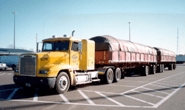Shipping and Logistics

ATA Report: America Depends on Trucking
Written by Sandy Williams
August 21, 2018
A new report by the American Trucking Association highlights America’s dependence on the trucking industry, revealing that 70.2 percent of all domestic freight tonnage is moved by trucks.
“Information, when presented properly and accurately, tells a story,” said ATA President and CEO Chris Spear. “The information in these pages highlights exactly what I tell elected officials, regulators and key decision-makers every day: trucking is literally the driving force behind our great economy. Safe, reliable and efficient motor carriers enable businesses throughout the supply chain to maintain lean inventories, thereby saving the economy billions of dollars each year.”
Among the findings in this year’s edition of Trends:
- Trucks moved 10.77 billion tons of freight, 70.2 percent of all domestic freight tonnage;
- The industry generated $700.1 billion in annual revenue in 2017, 79.3 percent of the nation’s freight bill;
- The industry moved 69.1 percent of all trade between the U.S. and Mexico, and 57.7 percent of Canada-U.S. trade;
- Roughly 7.7 million people were employed in jobs related to trucking activity, including 3.5 million drivers;
- Of those 3.5 million drivers, there were 1.7 million heavy and tractor-trailer drivers. Minorities account for 40.6 percent of all drivers, and 6.2 percent of truck drivers are women.
In an interview with Truck.com, Spear highlighted the need for younger people to fill the driver shortfall that is facing the nation. ATA estimates the industry is short at least 51,000 drivers, but many applicants do not have the training to be hired. Spears said the recruitment of younger drivers is a top priority.
“In many instances, you are making more in our industry in years one through five than you do coming out of college,” said Spear. “Letting us compete for the same talent as other industries is key.”
Currently, 48 states have regulations that allow drivers between 18 and 21 years old to drive heavy-duty trucks. Regulations, however, prohibit drivers under 21 from crossing state lines. which complicates scheduling in smaller states and for long-haul contracts.
A pilot program was recently approved to allow military veterans under 21 to drive across state lines, said Spear. “If we can train young talent to fight our wars, I’m convinced that we can teach 18- to 21-year-olds to drive across state lines.”
Legislation to lower the age for drivers crossing state lines has been proposed in both the House and Senate. Spear is hopeful of passage of the bills in 2019 and that younger drivers will help reduce the driver shortage during the next few years.
The industry also faces a shortage of trucks and the technicians to repair them, deteriorating highway infrastructure and inefficiencies in loading and unloading.
Tariffs and the Trucking Industry
ATA has been a participant in the ongoing NAFTA negotiations due to the importance of trucking to cross-border trade into Mexico and Canada.
“You look at the totality of trade policy and the role trucking plays to move that freight. We cannot afford not to be in this discussion,” said Spear.
Tariffs on steel and aluminum are also impacting the industry as truck and trailer manufacturers add surcharges to offset increased costs for materials.
“Right now, the lion’s share of my membership is willing to absorb some of this pain.” Spear said in the interview. “We just got a great tax reform bill through, but we’re losing that because of the tariffs. My hope is they are temporary and used as a negotiation tactic to get a deal and that those deals come quickly.”

Sandy Williams
Read more from Sandy WilliamsLatest in Shipping and Logistics

Wittbecker on Aluminum: US-China trade war clobbers cross-Pacific trade
Container shipping lines have sharply increased blank sailings on Transpacific routes in response to escalating trade tensions between the US and China.

Volvo plans to lay off up to 800 workers at US truck plants
The company cited uncertainty about freight rates and demand, regulatory changes and the impact of tariffs.

Trump signs executive order aimed at making US shipbuilding ‘great again’
President Trump on Wednesday signed an executive order meant to breathe new life into American shipbuilding and curb Chinese dominance in the sector.

Great Lakes iron ore trade fell again in March
Recall that shipments also saw a sharp decline in January.

Longshoremen ratify contract with maritime alliance
Nearly 99% of ILA members voted in favor of a new labor deal with the United States Maritime Alliance that covers workers at ports on the Atlantic and Gulf coasts.
